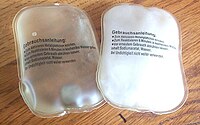
Photo from wikipedia
2D materials have shown great potential as electrode materials that determine the performance of a range of electrochemical energy technologies. Among these, 2D copper-based materials, such as Cu-O, Cu-S, Cu-Se,… Click to show full abstract
2D materials have shown great potential as electrode materials that determine the performance of a range of electrochemical energy technologies. Among these, 2D copper-based materials, such as Cu-O, Cu-S, Cu-Se, Cu-N, and Cu-P, have attracted tremendous research interest, because of the combination of remarkable properties, such as low cost, excellent chemical stability, facile fabrication, and significant electrochemical properties. Herein, the recent advances in the emerging 2D copper-based materials are summarized. A brief summary of the crystal structures and synthetic methods is started, and innovative strategies for improving electrochemical performances of 2D copper-based materials are described in detail through defect engineering, heterostructure construction, and surface functionalization. Furthermore, their state-of-the-art applications in electrochemical energy storage including supercapacitors (SCs), alkali (Li, Na, and K)-ion batteries, multivalent metal (Mg and Al)-ion batteries, and hybrid Mg/Li-ion batteries are described. In addition, the electrocatalysis applications of 2D copper-based materials in metal-air batteries, water-splitting, and CO2 reduction reaction (CO2 RR) are also discussed. This review also discusses the charge storage mechanisms of 2D copper-based materials by various advanced characterization techniques. The review with a perspective of the current challenges and research outlook of such 2D copper-based materials for high-performance energy storage and conversion applications is concluded.
Journal Title: Small
Year Published: 2022
Link to full text (if available)
Share on Social Media: Sign Up to like & get
recommendations!